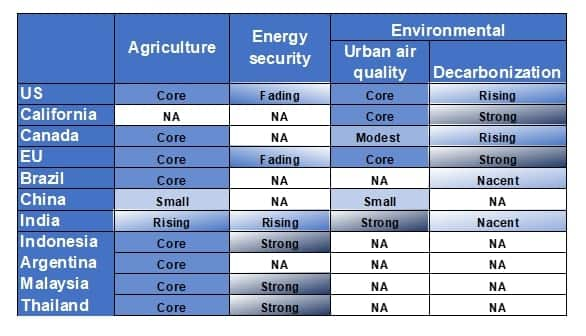The biofuel industry is developing at a pace with an increasing shift towards low-carbon fuels and the rapid development of climate change policies. There have been the world’s most ambitious policies implemented by The US and the European Union on alternative fuel promotion, including volumetric mandates, lifecycle fuel-carbon-intensity requirements, and fuel-taxation schemes.
There is an increase of direct and indirect biofuel ventures, ranging from technology to processing, agriculture and even the meat packing industry. Companies seeking to secure funding or investment banks looking to fund projects would need to take some key policy, key business and feedstock supply factors into consideration.
Three major policy areas are driven by Biofuels that vary over time and by jurisdiction.
- Policy environment on a global basis is highly fragmented
- Biofuels began as support agriculture, high octane replacement for lead in gasoline and energy security
- Global biofuels use has accelerated in the last 15 years due to the ban on MTBE in the United States and decarbonization
- Decarbonization will be the primary driver going forward in the OECD countries
- Agriculture and urban air quality will be major drivers in emerging markets


In order to capture supply chain synergies, downstream oil and biofuels supply chains are merging from the consumer to processing.
- By 2025, about 90% of renewable diesel and jet companies worldwide will be owned by refining companies, more than 70% in the United States.
- US and EU refineries are shutting petroleum operations and moving production to renewable fuels (12 so far)
- More than 20 percent of ethanol production in the United States is owned by refining companies and is likely to increase.
- Ethanol and renewable diesel plants (incl. converted refineries are expanding production to other bio-products such as jet fuel, naphtha, LPGs)
- Major investors/producers cut across the biofuels supply chain:
- Major oil companies—Brazil ethanol
- Refiners, ethanol majors, small independents—ethanol US
- Small independents—US and EU ethanol and biodiesel
- Refiners and majors—renewable diesel
- Agri-business—ethanol and biodiesel - Interest in investment is growing from refiners, agribusinesses, independents
- EVs are a common strategic threat

Global renewable diesel capacity – recent growth concentrated inside refineries

Policy impact on financials in Europe
EU biofuels mandates in 2020

Ambitious transport targets have been set for 2030
- Push to expand share of biofuels and renewables in European transport

Meanwhile, the European refining industry is seeing dark clouds ahead. Demand for motor fuel is dropping.
Europe has already hit peak demand
- New diesel passenger car sales have majorly declined, r esulting in sharply reduced demand outlook.
- Gasoline will make a temporary come-back because of the switch away from diesel. Longer term, gasoline demand will shrink, eroded by economy improvements and electrification of the fleet.
COVID-19 has led to deterioration of refining margins
- Even for the most complex configurations, NWE yardstick net cash refining margins are projected to stay below USD 2 per barrel until 2023 and below USD 4 per barrel through 2050.
- The core of Europe’s refining industry, FCC refining margins, are expected to go through a cash-negative period in next 3 years.
Refinery rationalization is inevitable
- By 2030, at least 2 MMb/d of European refinery capacity at risk.
- Almost 4 MMb/d when looking out to 2050.

Refiners are seeking to adapt their business models to remain competitive in the long-term
=> Turning to biofuels can be a solution!
Renewable Diesel offers short-term respite for refiners and longer term, biojet offers sustainable growth

RD held up quite well despite COVID-19
- In 2Q2020, Neste reported record biofuels sales
- Eni’s biorefineries in Gela and Porto Marghera (Venice) were its only plants which didn’t reduce runs in 2Q2020
- In 2Q2020, total indicated that La Mède was its only profitable refinery
S&P Global expects consumption of renewable diesel and biojet in Europe to grow from 3.3 MMt/y in 2019 to 8.6 MMt/y in 2050
- Investments in Renewable Diesel (RD)/HVO capacity are favorable context – although RD peak demand is around the corner.
- Pressure on aviation sector to decarbonize is mounting, and biojet is the only viable option in the short- to medium-term to meet CO2 emissions reduction targets
Policy outlook for Sustainable Aviation Fuel (SAF) remains unclear
- Several European countries/companies are taking explicit measures to tackle emissions in aviation sector
- Some capacity investments are now explicitly SAF-focused
- in early 2021, EU commission is planning on launching Sustainable Aviation Fuel legislation (RED-II 1.2 multiplier considered insufficient)
Impacts of Biofuels Policy on Financial and Volumetric
US biofuel blending assumptions by PADD – E15 adoption will be slow on poor blending economics. Renewable jet fuel, along with renewable diesel in PADD 5 for California LCFS compliance, will be a growth field in all PADDs.
Renewable diesel credit incentives


Biofuel policies dictate feedstock preference and feedstock is a key driver of production

Renewable diesel credit incentives
- Low carbon feedstocks (LCF)
- Used cooking oil, animal fats (tallow), DCO, PAO
- EU and North America
Agriculture Surplus
- Conventional domestically produced crops
- Palm oil, soybean oil and repassed oil
- US, South America and South East Asia
Energy Security
- All the above feedstocks
- Palm oil and soybean oil
- Lower imports of gasoline or diesel
- South East Asia
Feedstocks - 80% of biodiesel renewable diesel cost of production
- Feedstocks are mainly sourced from the agriculture and food industry. Next generation feedstocks may come from other sources.
Renewable diesel demand for LCF in North America and Europe to exceed LCF supplies.

Join other industry leaders and get more insights on Key Considerations in Financing Biofuels related investments















